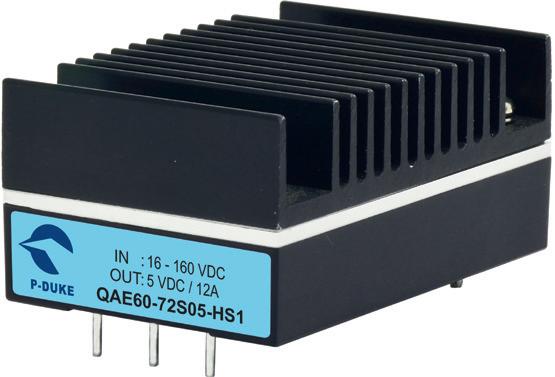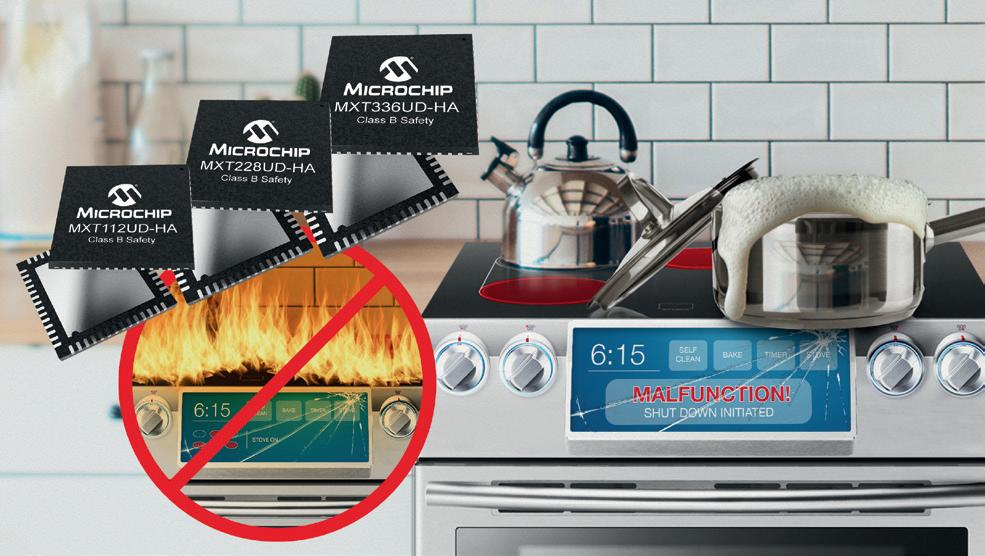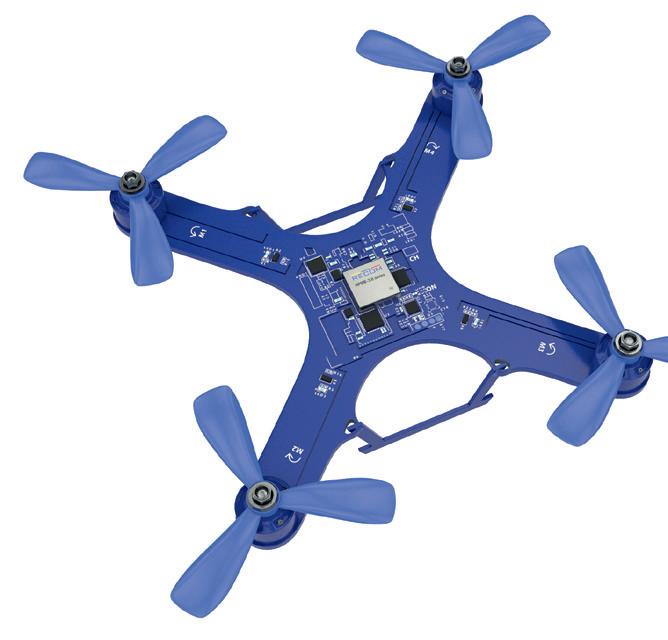
13 minute read
IoT still strong in difficult times
Joseph Zulick*
There are many business areas that are struggling currently, but the Internet of Things and Industrial Internet of Things are not included in this stress. If your concerns are around the risks of COVID-19 and the proximity of your co-workers, then you needn’t worry about the benefits of IoT and IIoT.
The strength of IoT and IIoT is being able to obtain data at a distance. We now have an even greater way to connect our information over further distances. Under the current business trends, we are trying to be more creative. This means we take the systems we used to have and now try to make them fit into our rapidly changing need for information.
One year ago, manufacturers were contemplating how they were going to weave IIoT into their fabric of information and their existing IT systems. Fast forward and we are now adapting to Zoom meetings, working from home and getting the answers we used to have by walking into a plant floor or running a report in the office.
Access is one of the biggest issues. How do we securely allow for remoting into the servers, and who can gain what system access? This can be a difficult situation because it’s very likely that what one person feels they need to access may not be what the IT department and supervisor deem necessary.
You need to determine who needs what and when. Can they openly access the IoT information that gets fed into reporting software or processors? Can you use firewalls that are time-locked out, much like the safes in the movies that can’t be opened until morning once they’re locked? Once you determine who is authorised and who needs the information, you can look at the next phase. But how?
How do the users need the information? Let’s use a simple example of a sensor that tracks the machine running or not running. Once that sensor feeds the information into the accumulation device or control through a gateway, it will be populated and push the information up to the cloud. Now the software that reads the sensor time on and off will put this into a register or location from which your other cloud programs will pull the information. You may have an OEE program that uses this information to produce a report on OEE or efficiency. This is a high-level report that may combine this information with downtime information that the maintenance department can use to do preventive repairs.
The uptime may combine with the data for the jobs to help managers in production to determine if they will meet their demands or may be used to let them know they will have to run overtime.
The above examples are departments or people that use this information, but there are many programs that will also need to pull this information. ERP (enterprise resource planning) and MRP (material requirements planning) systems will pull the same information and the register data to determine if the manufacturer has adequate supplies of raw materials and if the in-process work can be completed.
Other programs, such as maintenance programs that plan for preventive care using hours of runtime as a parameter, need to use these registers as well. The sharing of data with people and programs is a very important part of IoT.
We know accessibility and sharing are crucial to the value of IoT, but what else? Feedback. Once we have received the information,
©stock.adobe.com/au/putilov_denis

we need to take the data and adjust the parameters. Many of today’s sensors have adjustability; they have a sensitivity curve that can be adjusted and calibrated, based on environment or even chemical make-up. Many times, when we think about sensors and actuators we think about the ones we are most familiar with, but there are many types that can monitor chemicals, gases and position. In some of these sensors they need to have a manual adjustment or in many current sensors they have an electrical adjustment. The feedback gives you better control over the accuracy of the sensor and makes it more responsive.
Feedback also provides information back to smart controllers which are able to take data profiles and customise sensors to the job or application. Many sensors now are using a combination approach. Using optical sensors in conjunction with accelerometers gives a great range of motion to track position.1 Other sensors use depth, optical and acoustical sensors to work in synchronisation for inputting on the Microsoft computer using their Kinect system.
Programming sensors and tracking their function gives you a far better result. The details of each sensor can be modified, and the status of the sensor can be tracked and compared against historical benchmarks.
One issue that comes up in sensors is that the closer you set a transition, the more likely you are to receive errors like switch or sensor bounce. This shows up as multiple openings and closures of the sensor. Smart systems provide solutions for this by ignoring transitions that happen too close to the first transition or using other measures to move the transition point into an area that is more stable.
An often-overlooked solution in the IoT world is to look at the actuator for the sensor. In many cases, the switch arm or flag for the proximity switch may not be optimally set up. Perhaps using a different switch arm with a different range of motion, or one that uses a larger actuating point, gives a better performance.
Smart sensors use field processing that allows for sensors to be processed at the field level and only transmit the ‘clean’ information. This means that it is processed and attenuated to the proper levels and has some level of security and field wiring protection.2 Many now come in a single package that provides a gateway/communication, voltage and failure monitoring, and back-up.
With more and more demand to have these sensors wireless and mountable in other locations, more demand for performance is desired. Failure is not an option and a plan must be part of your IoT solution for all foreseeable problems; this includes signal outage and power outage. You need to have a plan for addressing this sensor data when a failure occurs.
If you think about autonomous vehicles and their sensors, the more we rely on the sensors and the IoT, the better the reliability must be when lives are at stake. We have seen some of these failures end in accidents, so we must be diligent in optimising the performance of our sensors.
All parts of the IoT are on the rise and all must be improved to keep up with the demand: sensor performance, failure rate, gateway, communication and cloud infrastructure, and upgrading all of our software and program speed and processing.
Everything in our future Jetsons world must be dynamic and flexible to rise to the challenge of technology. In manufacturing optimisation, we talk about the fact that a chain is only as strong as its weakest link. The IoT is working on all phases to not be that weakest link. Sensors are improving to use less energy so they can run off backup for a longer time. Redundant systems are backing up the data. Gateways are becoming more secure and faster while using better communication protocols. The speed of 5G is right around the corner and our programs are being redesigned to process faster.
The future of IoT is bright indeed. Wear shades as needed!
*Joseph Zulick is a writer and manager at MRO Electric and Supply.
References 1. Augmented Reality Hardware by Alan B. Craig, in Understanding
Augmented Reality: https://www.sciencedirect.com/topics/computerscience/multiple-sensor 2. Smart Sensor Technology for the IoT: https://www.techbriefs.com/ component/content/article/tb/features/articles/33212
DC/DC CONVERTERS Helios has announced the QAE100U series DC/DC converters from P-DUKE, which expand the existing series QAE40U and QAE60U to 100 W of output power. The letter ‘U’ in the series name refers to its ultrawide input range, including 8:1 of 9–75 VDC and 12:1 of 14–160 VDC. One single 12:1 ultrawide input range module can cover each kind of power system of rolling stock.
QAE100U is designed for rolling stock applications. Its 12:1 input range of 14–160 VDC can be suitable for 24, 36, 48, 72, 96 and 110 VDC power systems described in EN50155 and complies with the safety standards of EN50155, EN45545-2, IEC60950-1, IEC62368-1 and EN61373.
The product provides a single output with 5, 12, 15, 24, 28, 48 and 53 VDC output voltage. It can be installed on a PCB or chassis securely via screws. Heatsink options are also available for thermal demands. Helios Power Solutions www.heliosps.com.au INDUSTRIAL DATA ACQUISITION SYSTEM The Dewesoft IOLITEd is an industrial data acquisition system that brings easy-to-use data acquisition to industrial and monitoring applications. All signal amplifiers are designed to offer high-end signal conditioning with 24-bit resolution and a high sampling rate of up to 50 kHz/channel.
The product achieves high-end signal conditioning with a range of input and output slots, allowing the measurement of voltage, current, strain, stress, vibration, sound, temperature, digital, counters and more. Dewesoft X data acquisition software, featuring a series of supported industry-standard interfaces, works with the hardware to perform data collection without losing even a single sample. It also provides data visualisation and processing capabilities. Data can be stored in a time-series database and served to SCADA systems using standard interfaces such as OPC UA or XCP to support Industry 4.0 applications.
The device comes in single- and multi-channel versions. Multiple modules can be daisy-chained together with a single Ethernet/EtherCAT cable with RJ45 connectors. Devices can span up to 100 m apart and a single EtherCAT cable is enough for power, data and synchronisation between devices. Metromatics Pty Ltd www.metromatics.com.au


SAFETY-CERTIFIED CAPACITIVE TOUCHSCREEN CONTROLLER FAMILY To reduce the risk of fires in the kitchen and flooding in the laundry, European IEC 60730 and US UL 60730 Class B specifications require safety mechanisms in home appliances such as ovens, cooktops, washing machines and clothes dryers. Helping designers meet these functional safety requirements in touchscreen-enabled appliances, Microchip Technology announced its maXTouch MXT336UD-MAUHA1 capacitive touchscreen controller family — said to be the market’s only touchscreen controllers to offer pre-certified, Class B firmware. The family includes three controllers — the MXT112UD-MAUHA1, the MXT228UD-MAUHA1 and the MXT336UD-MAUHA1 — each fulfilling different screen size needs, ranging from 2 to 8″ .
The Class B-certified touch controllers offer safety-related features that enable system shut-off through an intuitive soft button on a touchscreen, removing the requirement for an external safety certified stop or cancel button and associated microcontroller (MCU). They also allow an appliance to detect a touchscreen or appliance failure and shut down automatically through a variety of self-testing capabilities. For example, if the glass breaks on a cooktop, the touchscreen will turn dark and shut off the machine, eliminating accidental damage in the home. As the number of touch-enabled home appliances continues to increase, the family shifts the required safety functionality to a simplified single touchscreen interface, helping OEMs reduce costs and improve time to market. In addition, the family leverages a high signal-to-noise ratio (SNR) design and proprietary differential mutual acquisition scheme. This allows the machine to detect and track multiple fingers on surfaces exposed to moisture, water, grease and more — even if the user is wearing gloves. Microchip Technology Australia www.microchip.com

A long-term goal for RECOM has been to develop DC/DC converters which can be handled, placed and soldered like any other modern SMT component, but also with a low profi le to match today’s slimline products.
What are the challenges with current packaging design for DC/DC converters?
Power density is one of the most important properties of a modern DC/DC converter design. Shrinking the design requires placing power components closer together. By doing so, you’re placing multiple heat sources near one another, so one of the main challenges current packaging designs face is getting the heat out effi ciently. Thermal design considerations in very high density designs become crucial.
Another major challenge with any DC/DC converter design is EMC. One way to increase the power density is to shrink the size of the passives by increasing the operating frequency of the converter (faster switching requires smaller component values). But if you do this, the layout of the board often determines if the converter will pass or fail an EMI test. A good way to keep the parasitic elements in a circuit low is to limit the length of connectors on your PCB, but traditional packaging designs have limits to how short these traces can be.
What are the benefi ts of advanced packaging techniques?
One of the advanced assembly techniques which really helps to overcome the challenges of current packaging designs is FCOL (flip-chip-on-leadframe) power components. This technique not only signifi cantly reduces the connection parasitics, but by fl ipping the IC and placing it directly on a leadframe, the FCOL design also has a dramatically reduced thermal resistance. The assembly technique allows higher switching frequencies to be reached while still meeting strict EMC requirements.
In RECOM’s 3D Power Packaging® technology, we additionally put active and passive components directly inside the PCB. This achieves similar results to the fl ip-chip-on-leadframe approach by shortening power paths and reducing the thermal resistance of the design, thereby allowing us to reduce the solution size and increase the performance of the module.
We’re also using different techniques to solve different problems. There is no point making the converter smaller if you can’t manage the heat and the electromagnetic disturbances it then creates. Customers often demand a holistic solution which addresses all thermal, EMC and power performance requirements in a single unit — in other words, they want a plug-and-play solution. For such customers, the RPM series is the way to go. It is a compact module that requires the minimum of external components (for example, two resistors to set the output voltage) to create a complete DC/DC power supply.
How is RECOM Advanced Packaging technology used for low-power DC/DC converters?
Advanced packaging technologies such as 3D Power Packaging are used in over-moulded fl ip-chip-on-leadframe designs, embedded active and passive components in the PCB, and multi-level designs. This helps RECOM to increase power density and raise switching speeds without harming the thermal performance.
Tell us about your products leveraging advanced packaging technologies.
The RPM, RPMB, RPMH and RBB series all use thermally optimized, multilayer PCB technologies with BGA chips and the RPX series incorporates FCOL technologies. And fi nally, the new RxxCTxxS uses a multi-level design and air-core transformer to reach very high isolation levels in a very low profi le, IC-type over-moulded package.
The application of product is closely related to the development of industries. Can you share some applications that RECOM Advanced Packaging technology mainly focuses on?
We are very fortunate that our large product portfolio addresses various customer segments across the industry. The 3D Power Packaging products suit almost all kinds of applications and fulfi l the market requirement of minimized PCB footprint, high power density, fully automated production process and time to market, as well as ease of use.
One example is drone applications (see image); the power module shown in the drone is up to 6 A for high power, which is good for the battery in drone applications. Other uses include telecom applications, ie, set-top boxes and gateways, for smart metering like 5G, industrial, robots, medical, mobility, energy, automotive, etc.







